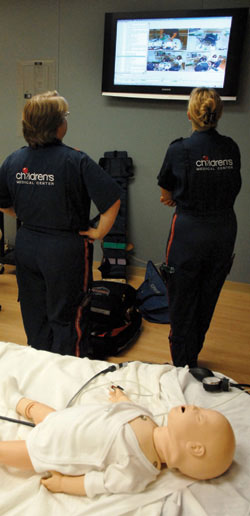FEATURE
STORIES
Nursing education reinvented: Much more than a place that educates students
The benefits of the Smart Hospital go far beyond nursing education.
As graduating nurses leave the University, they take with them a portfolio of their training. When they begin working at a hospital, they are required to receive a six- to 18-month orientation, depending on what type of patients they will have.

Transport team members from Children's Medical Center in Dallas review their efforts to revive SimBaby. Area medical facilities use the Smart Hospital for re-credentialing.
“We anticipate that our graduates’ portfolios will save employers time and money during that orientation process because of the tasks and skills and scenarios they will have already experienced in the Smart Hospital,” said Judy LeFlore, director of the Pediatric and Acute Care Pediatric Nurse Practitioner programs.
The facility can be used for continuing education and credentialing of health care providers and emergency responders. The pediatric intensive care unit and transport team at Children’s Medical Center Dallas is already taking advantage of this.
“Not only do they have the chance to get re-credentialed,” Smart Hospital manager Tiffany Holmes said, “but they go through the process on all the latest technologies and state-of-the-science equipment used in nursing.”
Nursing Dean Elizabeth Poster cites these partnerships with health care agencies and systems as one of the hospital’s distinguishing characteristics.
“Medical Center of Arlington has provided funding to hire two additional staff, and as part of this collaborative relationship, their nursing staff will also be using the Smart Hospital on a planned schedule,” she said.
Nursing faculty using the hospital as a research lab are partnering with others at the University, including researchers in nanotechnology, kinesiology and computer science.
“Nursing badges in new hospitals often come with radio frequency chips in them. Through this RFID technology, which the Smart Hospital is equipped with, we can study the efficiency of nurses in such a way that we can track how many times they go into a room, why they go into the room and how long they are there,” Professor Beth Mancini said. “The opportunities for this level of research are endless.”
Other collaborations, such as those with founding corporate partners Laerdal Medical, Hill-Rom and Cardinal Health, benefit students and the community.
Cardinal Health produces cost-reducing and safer products for the health care industry. The Smart Hospital houses three of Cardinal’s Pyxis stations, automated systems that more accurately dispense medicine and supplies.
Laerdal is the world’s leading manufacturer of the SimMan and SimBaby full-body simulators. As a Laerdal Center of Excellence in Simulation, the Smart Hospital will be integrating simulation with patient care products from Hill-Rom, which has established its National Demonstration Showcase there. Hill-Rom is one of the largest manufacturers of hospital furnishings worldwide.
The National Demonstration Showcase will feature Hill-Rom’s product and service systems and help answer the questions: What is the best way to orient the equipment? What is the best way to teach nurses how to use a new bed? What is the best way to maximize the efficiency of the equipment or how to use it differently? How can nurses be sure that the equipment they’re using does not threaten their own well-being?
“Having students provide safe patient care while also learning to prevent their own back injuries is an important way to ensure their retention in the work force upon graduation,” said Dr. Poster, noting that injury is a major on-the-job hazard. “According to the American Nursing Association, about 12 percent of nurses leave the profession annually, and more than 52 percent complain of chronic back pain.”
Poster says replicating a real working environment will help alleviate these hazards by instilling better practices at an early stage.
With partner HKS, a major hospital architecture firm, educators can look at the best way to design hospital rooms.
“These collaborations will allow us to study things like the compatibility between placement of equipment and the patients in proximity to the nurses and the degree of labor in which they administer care,” said Dr. Mancini, who added that this kind of efficiency research is invaluable given the shortage of nurses.
“Limited clinical space can limit the number of students in some nursing schools. By using the Smart Hospital for simulations, students may need less time becoming comfortable, confident and competent in the hospitals. Therefore, we can use the same space for more students.”
— Susan M. Slupecki
Other Stories
Leadership investments
Corporate gifts establish Goolsby Academy scholarship, professorship
Mavericks Personified: Tommy Le Noir
Alumnus brings crime-solving savvy to reality series
The speed of life
Professors’ book examines fast-paced families
Former stars join athletics hall
Ceremony also honors men’s track and field teams
Alumni Association awards scholarships, hosts programs
Search
Contact Us
Office of University Publications
502 S. Cooper St.279 Fine Arts Building
Box 19647
Arlington, TX 76019-0647
